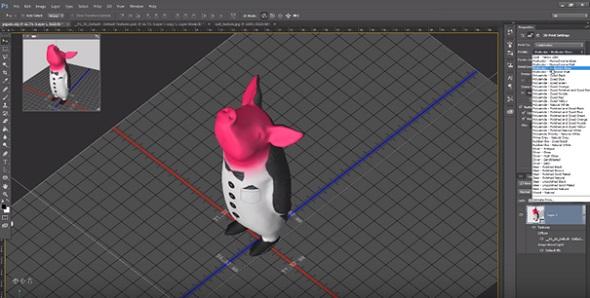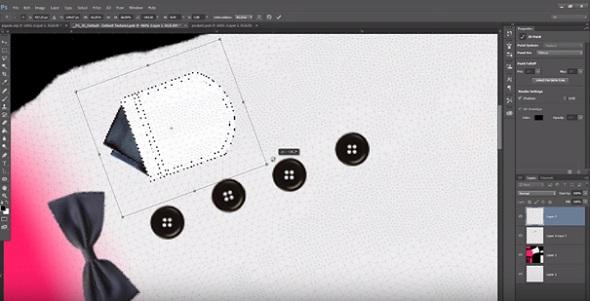 You know that old time-tested program, Photoshop, that many of us have used for perhaps decades? Well, now Photoshop has updated its functions to fully accommodate 3D printing with i.materialise in over 100+ finishes and materials. This is due to a partnership with i.materialise that makes it easy to use Photoshop CC to edit models and then get them 3D printed. Even better, the people at i.materialise have made it easy to do all this by providing a hands-on video tutorial and information site that will take you through the process, step by step.
You know that old time-tested program, Photoshop, that many of us have used for perhaps decades? Well, now Photoshop has updated its functions to fully accommodate 3D printing with i.materialise in over 100+ finishes and materials. This is due to a partnership with i.materialise that makes it easy to use Photoshop CC to edit models and then get them 3D printed. Even better, the people at i.materialise have made it easy to do all this by providing a hands-on video tutorial and information site that will take you through the process, step by step.
So how do you use Photoshop to create 3D models? In the tutorial, you’ll learn how to edit using different views, how to edit in the space and in the UV skin, and how to print 3D models. Using a model of a “piguin” (pig and penguin combination) you’ll learn to import common 3D formats like PLY, OBJ, IGS, and STL — of course. If you don’t have a 3D file, there are plenty of model databases here that can help you find one.
After you have learned about import files, it will be time to learn about the basic controls like manipulating and rotating the view, zooming in and out, and switching between views of your model that have been pre-identified (like the main and secondary views.)
Step 3 of the tutorial has you learning to use Photoshop to investigate the 3D model. You can change layer characteristics of your model, which is explained here:
“With the segmented view for instance, you can virtually cut your model open on the X, Y, and Z axis to take a look inside your model. You can also display the design as a point cloud wireframe structure and switch other effects such as shadows off or on.”
Are you beginning to get the impression that Photoshop has really gone all out here to include many complex functions as you design your 3D model?
 Take Step 4: painting your 3D model. This is one of the best examples of how a program like Photoshop CC can be especially useful when you are designing your model. And i.materialise asks the correct question: “Which other 3D modeling or design software can offer editing tools as powerful as those that Photoshop has to offer?” The program’s ability to let you paint your 3D model in space allows you to try out many different colors.
Take Step 4: painting your 3D model. This is one of the best examples of how a program like Photoshop CC can be especially useful when you are designing your model. And i.materialise asks the correct question: “Which other 3D modeling or design software can offer editing tools as powerful as those that Photoshop has to offer?” The program’s ability to let you paint your 3D model in space allows you to try out many different colors.
You can also switch your model from 3D to 2D to paint its skin (Step 5):
“This means that the UV skin of the model will be unwrapped and easy to edit. You can change the UV overlay capacity, select the brush size and hardness of your choice, and use any of the Photoshop editing tools you have in mind. For example, you can add effects and filters such as noise, distortion, pixelation and many more.”
Next, in Step 6, you learn to import files and images into your 3D model. These images, after imported, can be modified by the Photoshop editing tool of your choice. This includes the ability to work with texturing and layering once you’ve imported them in the 2D view and then navigated the images to the correct place.
The final step is an easy one: when your model is ready to be 3D printed, you simply hit the “print” button, select i.materialise as your printing service, and then choose your color and finish. You can preview the model by clicking “prepare to print,” and once that has happened and you feel good about printing your model — you are ready to go!
I don’t know about you, but after hearing all of this, I can’t wait to try Photoshop CC! What do you think? Tell us over in the Photoshop & 3D Printing forum at 3DPB.com.
Subscribe to Our Email Newsletter
Stay up-to-date on all the latest news from the 3D printing industry and receive information and offers from third party vendors.
You May Also Like
Gorilla Sports GE’s First 3D Printed Titanium Cast
How do you help a gorilla with a broken arm? Sounds like the start of a bad joke a zookeeper might tell, but it’s an actual dilemma recently faced by...
Nylon 3D Printed Parts Made More Functional with Coatings & Colors
Parts 3D printed from polyamide (PA, Nylon) 12 using powder bed fusion (PBF) are a mainstay in the additive manufacturing (AM) industry. While post-finishing processes have improved the porosity of...
$25M to Back Sintavia’s Largest Expansion of Metal 3D Printing Capacity Since 2019
Sintavia, the digital manufacturing company specializing in mission-critical parts for strategic sectors, announced a $25 million investment to increase its production capacity, the largest expansion to its operations since 2019....
Velo3D Initiates Public Offering in a Bid to Strengthen Financial Foundations and Drive Future Growth
Velo3D (NYSE: VLD) has been among a number of publicly traded 3D printing firms that have attempted to weather the current macroeconomic climate. After posting a challenging financial report for 2023,...

































